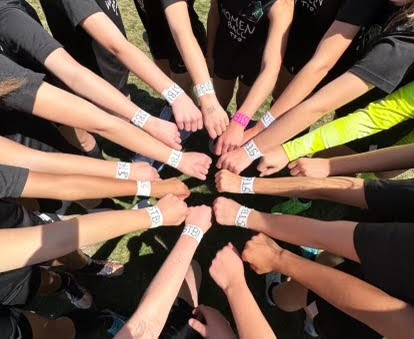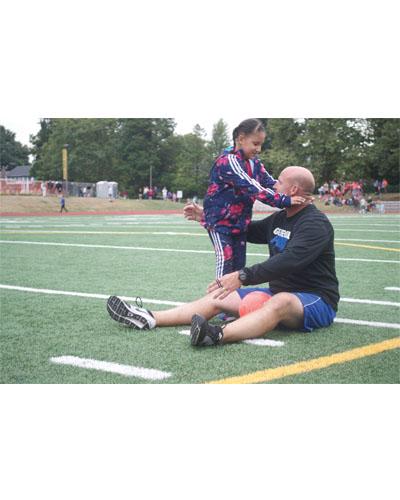
Although most of the preliminary laws may be in place, there is still much to be done socially so that transgender athletes feel safe.
“Alright ladies, line up,” my coach says as I force myself to keep the smile on my face and chant “G-G on three, one, two, three.” I push off the wall and leave the “ladies” behind me, out of the pool and out of my mind, putting all my focus on the game.
I have played water polo for over five years. It has been there for me through friendship trials, mental health crises and innumerable other challenges. For that, I am forever indebted to the sport.
The way my gender identity interacts with the sport, however, is a different story.
The summer before freshman year, doubts surrounding my sexuality and gender were swirling in my brain. Just weeks out of Catholic school, I was still trying to come to terms with my queer identity. To then begin actively questioning my gender after ignoring it for years fast-tracked my depression spiral, causing a school switch and other changes. Through it all, water polo was the constant.
I can honestly say that I wouldn’t be alive without it.
However, as I’ve come out as transgender, I’ve been faced with new challenges, most notably deciding what team to play for.
Legally, I can play for the boys’ team. In the state of Oregon, transgender athletes are protected under anti-discrimination laws, allowing them to play for the boys’ team pre-and-post medical transition. Before a medical transition, which is not something I have begun, female to male (FTM) players can play for the girls’ team; after beginning any type of medical transition, they cannot play for the women’s team. Unfortunately, this decision is often more complicated than that. Essentially, trans athletes are legally allowed to play for the team that best matches their identity, but there are discrepancies in the laws regarding protection from coach and player harassment.
For me, I had to decide if I wanted to forego my starting spot, my title as captain and being on a team with the coach I worked with better to risk further harassment, less playing time and teammates that respected me far less. In the end, these factors, among others, contributed to my decision to play for the “girls” team this past year.
“I made the decision that was best for me,” Schuyler Bailar, the first NCAA transgender swimmer, says. “And that happens to be that I wanted to be on the men’s team, and I wanted to keep swimming and that was what felt the best to me.” He adds that “there are plenty of people that that doesn’t work for them.” Ultimately, I need to do what is best for me, just like others need to make the choice that is best for them.
Transgender athletes around the country are facing decisions like mine. Ultimately, it is up to the athlete to do what they are most comfortable with. Unfortunately, it is a more loaded decision than playing for the team that matches your gender or not.
Even practicing with the boys’ team resulted in harassment, and this is not uncommon for trans athletes, regardless of the team they play for. I imagine that harassment would have only multiplied if I had played for the boys’ team.
There are differences in being a female to male (FTM) and male to female (MTF) athlete. These discrepancies stem from people’s fear of a cisgender male posing as trans to gain an advantage in by competing in against cisgender women. However, these concerns are not grounded in fact. Not only would anyone willingly choose to face harassment and risk their ability to get jobs and receive medical care, the International Olympic Committee (OIC) tests athletes competing for their testosterone levels. “This take-over of women’s, women’s sports hasn’t happened. Women are still dominating women’s sports. Also, trans women are women,” Bailar says.
Although complex on the surface, allowing athletes to compete with their gender identity offers a host of benefits, such as improving mental health by affirming identity. It is understandable that there are concerns about those that have undergone testosterone-driven puberty competing with cisgender women.
But is there really any harm in allowing transgender individuals to compete with their gender? Because sports, at least for the majority of us, are not something we will pursue at the Olympic level.
For me, water polo is something I intend to continue playing in college. But for now, I am taking a break. It is my first break in six years of playing the sport, and although I love it, I needed some time away. After a rough high school season, I wasn’t ready to decide if I was playing for the boys’ or the girls’ team. I wasn’t ready to field more questions and face more harassment from other teams if I do decide to play for the boys.
There is one quote from Bailar that sticks with me today. He says, “I refuse to let anything, including my own discomfort with my body, take that from me.” Similarly, my relationship with water polo is complicated. Internally, I struggle with confidence and body image, and externally I face transphobia and misgendering. In the end, however, I have a deep love for it and intend to return, even though change still needs to occur for me to feel fully comfortable.


































